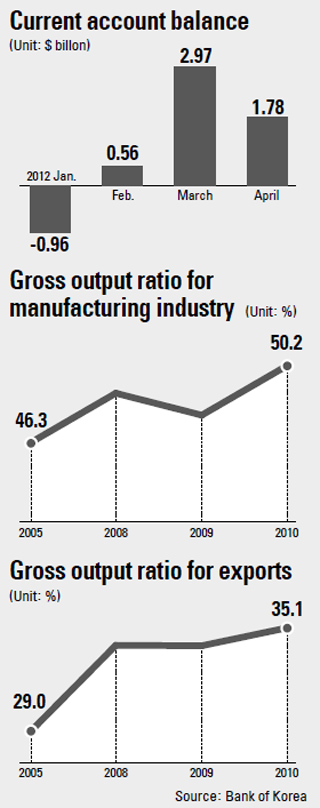Trade surplus survives export slip

According to the Bank of Korea yesterday, the surplus stood at $17.8 billion last month, down slightly from the previous month but continuing the rebound seen since it sloshed to a deficit of $970 million in January.
Imports remained steady at $44 billion but exports slipped from $47.4 billion to $45.9 billion as Europe’s sovereign debt crisis clouded the global market.
This renewed concern about how Korea’s export-dependent economy will fare given the prospect of a euro meltdown and a hard landing for China.
The central bank said the downsizing of the current account balance largely came down to improvements in the capital and financial account.
This reached a net inflow of $20 million last month, marking a turnaround from a net outflow of $1.86 billion in March as dividend payments to foreign investors dwindled after they offloaded their holdings.
The service sector account surplus shrunk from $700 million in march to $550 million in April.
The central bank sees the slipping surplus as a temporary blip.
“Although exports of IT products and telecommunications equipment have been slowing, automobile exports continue to show strong growth and import costs have eased in line with international raw material prices,” said Yang Jae-ryong, a BOK official.
Yang said the current account balance will likely expand next month as dividend payments to overseas investors were settled in April.
“The surplus on goods in May is expected to resemble that seen last month.”
Despite optimism over the upward trajectory of the current account, the central bank has called for fundamental economic change and argued - in a separate report - that the situation is now critical.
As of 2010, trade accounted for 32.9 percent of Korea’s total gross output, up from 31.8 percent in 2009, making the country increasingly susceptible to the ill effects of a slowdown in its top trading partners.
Compounding fears, manufacturing coverage exceeded 50 percent two years ago, for the first time since 1988, and there are no indications it has dropped since.
Economic contributions from the service industry, which is more resilient to external shocks, have been edging down.
The service industry’s accounted for 37.7 percent, down 39.3 percent recorded in 2009.
This was the lowest contribution reported since 1998.
Although the domestic manufacturing industry continues to grow, fewer new jobs are being created as companies increasingly switch to automated systems while higher crude prices are an added burden eating into companies’ bottom lines.
Market observers have repeatedly stressed the need to reduce the dependency on export and the need to expand the service industry to strengthen the domestic market and balance out the nation’s industrial structure.
“Export and manufacturer’s coverage have expanded while the service industry shrunk as leading conglomerates have continued to enjoy strong growth after the global crisis in late 2008 while the domestic market has shrunk,” said an analyst.
In 2010, the latest year for which data is available, gross output including from the manufacturing and service sectors hit 3,733 trillion won ($3.2 billion), up 13.6 percent from 2009. Gross output is a key gauge for measuring the size of an economy.
By Lee Ho-jeong [ojlee82@joongang.co.kr]










with the Korea JoongAng Daily
To write comments, please log in to one of the accounts.
Standards Board Policy (0/250자)